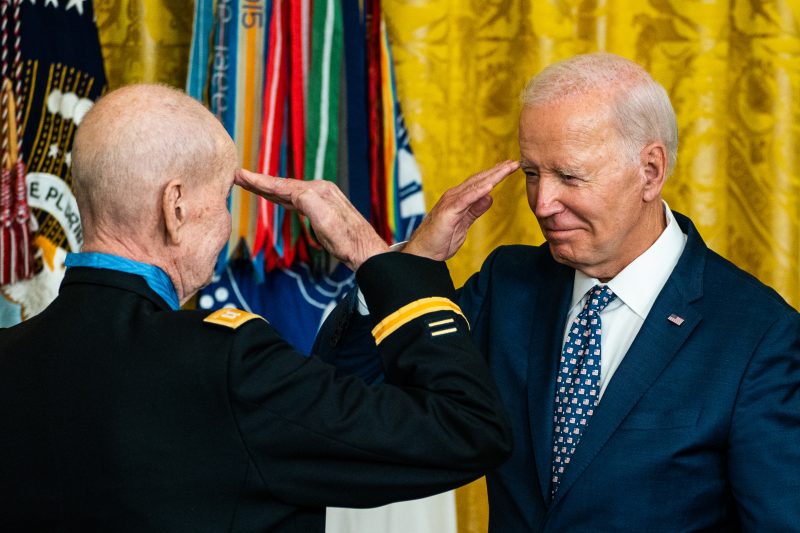Walking with purpose, pulling up his shirt sleeves, glad-handing voters, commanding the podium — the images of Joe Biden flashing across swing-state television and computer screens since late August present a vibrant and pointed departure from the way most Americans now see the president.
About 3 in 4 U.S. adults recently told CNN pollsters that Biden failed to inspire confidence and raised “serious concerns” about his physical and mental competence. But this is a different leader shown in the new ads: Here he is before Congress saying no one should bet against America. There he is at the rope line giving a Black teenager a “go-get-’em-tiger” tap on the chest. Wages are rising. Manufacturing is back.
The contrast helps explain why the Biden campaign has decided to buck precedent by launching a major advertising buy sooner than Barack Obama or Donald Trump, the last two presidents to run for reelection.
It’s a major investment for a still-growing campaign. Through the end of June, Biden’s campaign organization had raised less than $23 million, all in checks no larger than $3,300. The same account is now shouldering the costs of the first weeks of a $25 million, 16-week television and digital campaign, overwhelmingly aimed at the swing-state voters that will decide the election. A person involved — who spoke on the condition of anonymity because they were not authorized to speak publicly on internal discussions — said it remains uncertain whether the campaign will foot the entire bill through December, or whether the deeper pockets of the Democratic National Committee and state parties begin to spend as well.
The full ad campaign has separate spots to target Hispanics — with a Puerto Rican accent in Pennsylvania and a Mexican one in Arizona — with a separate tag line, “Somos Nosotros,” or “It’s Us.” African American spots praise Biden’s work to cut “Black child poverty” and grow “Black businesses.” An abortion rights message is covered with a female narrator, while a young mom cement mason in the Wisconsin testimonial says Biden is “helping real people.” Unlike Obama, who relied heavily on direct-to-camera speaking for his positive spots, these narrated ads typically unfold as montages of the American people and Biden in action.
Veterans of past Democratic presidential campaigns such as former Obama campaign manager Jim Messina and Jim Margolis, an ad man for Obama and Hillary Clinton, praised the unusual strategy as smart politics. The first major ad buy for Trump’s reelection bid didn’t come until October 2020 and Obama waited until March of 2012 to start sustained spending, after a short burst in January to push back on Republican ads.
But the early spending is also an implicit admission of the challenge of reaching voters in an evolving media landscape, which has been a focus for the Biden team, who spent the early years of Biden’s presidency researching the rise of social networks like TikTok and crafting new strategies to respond. Biden’s particular weaknesses include his struggles to attract attention through the news media.
“I think the distance between what the president has accomplished and what the public perceives in terms of performance is disconcerting,” Margolis said in an email. “Right now the campaign has the opportunity to begin to tell their story, mostly without opposition advertising getting in their way.”
John Del Cecato, a Democratic ad-maker who worked for Obama and the 2020 campaign of Transportation Secretary Pete Buttigieg, calls the strategy a “gamble worth making” to raise Biden’s approval rating from the low 40s, which is on par with where both Obama and Trump were at this point in their reelection cycles, according to Gallup.
“He has got to kick it up a notch,” he said.
This same discomfort has Trump’s team crowing, even as they focus on juggling four separate criminal indictments and a ragtag debate stage of Republican rivals.
“If you are incumbent president and you are spending $25 million more than a year ahead, it doesn’t take a rocket scientist to figure out you have a problem and need to fix it,” Trump adviser Chris LaCivita said.
Even in an off year, Biden aides say $25 million buys the Biden campaign about 3,500 gross ratings points in northern states like Pennsylvania, Michigan and Wisconsin, and 2,000 or more points in Arizona, North Carolina, Nevada and Georgia, with a similar volume of digital spending.
As a rough approximation, 100 ratings points allows all viewers to see a spot once, so 3,500 is a frequency of 35 ad views per viewer. Over 16 weeks, this works out to about 20 percent of the ad volume that a presidential campaign typically runs in the closing months, according to ad buyers.
The buy includes some national cable advertising on MSNBC’s “Morning Joe” — a favorite of Biden’s during his morning workout — as well as daytime Fox News and prime time CNN. The Biden team has concluded that the daytime audience on the generally anti-Biden Fox News includes a surprising number of the campaign’s target voters.
Major news events are also a focus of the buy. He purchased a 60-second ad in swing states on Sunday’s broadcast of CBS’s “60 Minutes,” a spot focused on his efforts to support Ukraine against the Russian invasion that will air while Biden is overseas on a foreign trip. He also bought time in key markets during the first game of the NFL season last Thursday, focused on Biden’s efforts to lower inflation.
But the bulk of the money is going to traditional swing-state broadcasts, digital platforms like YouTube and even streaming television offerings like Hulu and Freebie, the campaign said. Some of the Spanish-language advertising is going to WAPA, the Puerto Rican television network that is watched in states like Pennsylvania.
The advertising campaign is being led by three returning veterans of the 2020 Biden campaign: Patrick Bonsignore, the 2020 director of paid media; Adrian Saenz, who put together this cycle’s Latino-focused ads; and Terrance Green, who is overseeing African American outreach. Mike Donilon, a longtime ad man for Biden, still works as a senior White House adviser and has occasionally weighed in on the effort in his personal capacity, like other top Biden political advisers still working in government, according to people familiar with the effort.
“In a fragmented media environment, it’s more important than ever for our campaign to be investing early and aggressively across platforms to deliver our message where voters are,” Biden campaign manager Julie Chavez Rodriguez said in a statement. “While Republicans duke it out and burn cash fighting each other, our campaign is reaching our general election audience early and consistently — which is critical for winning in November 2024.”
The decision to spend such a large slice of the early off-year fundraising is driven in part by the Biden reelection effort’s ability to offload many of the early costs on accounts with higher donation limits controlled by the Democratic National Committee and affiliated state parties. Biden campaign staff only started working out of offices in Wilmington, Del., in recent weeks, after working the first months from borrowed desks at the national party headquarters.
The strategy also indicates the campaign’s confidence in raising significant money next year, as they have essentially abandoned the traditional approach of early stockpiling of campaign funds to be used in the final weeks before Election Day, when candidates are given lower rates on television than outside groups. Democrats widely believe that Biden’s Republican opponent, who most now expect to be Trump, will provide more than ample incentive to open a 2024 spigot of small-dollar donations.
“They will have all the money they need to do this. We have this thing called the internet,” said Messina, the 2012 Obama campaign manager. “The internet provides.”








